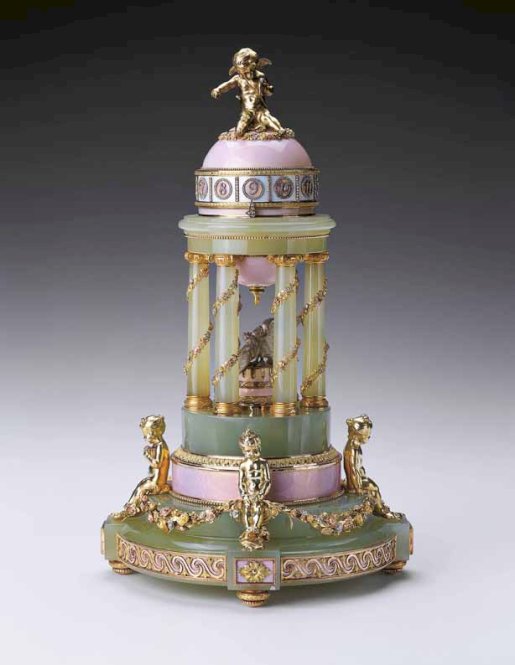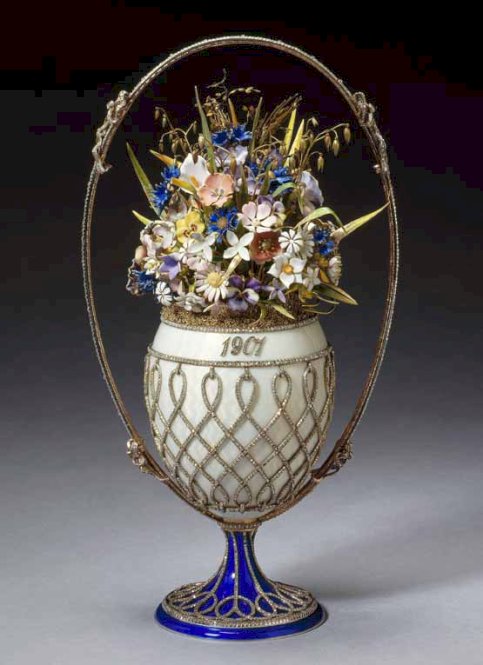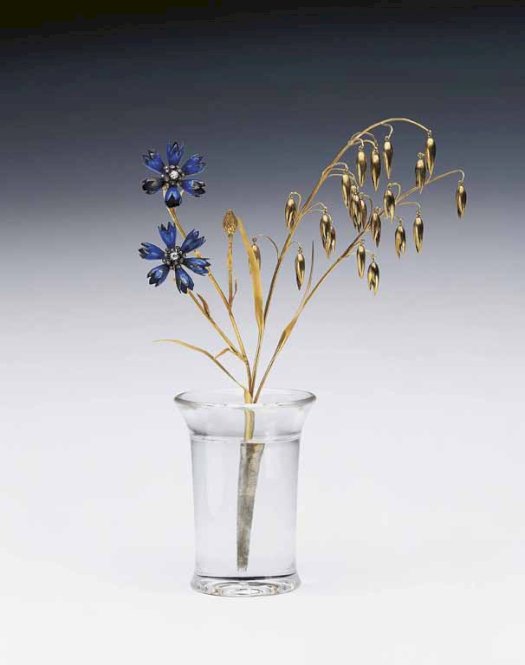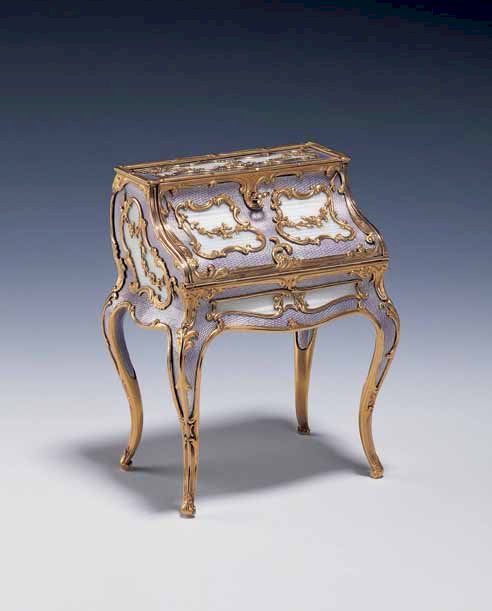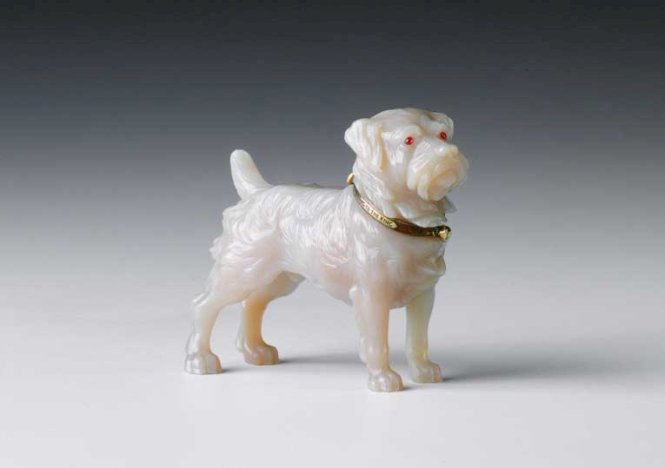Fabergé & the Royal Collection
To commemorate the coronation of King Charles III, we have put together a selection of some of our favourite pieces owned by the British royal family, and in the Royal Collection Trust today.
The Royal Collection of Fabergé is not only one of the largest in existence, but is also one of the most important. This is because the nucleus of the collection was either acquired by Queen Alexandra and King Edward VII direct from Fabergé, or was given to them by relatives or friends who also bought the pieces from the same source. Subsequent members of the royal family, including HM Queen Elizabeth II and King Charles III, have added to the collection. It includes everything from crochet hooks to Imperial Easter Eggs, as well the world’s largest menagerie of Fabergé hardstone animals and a group of flower studies.
The Basket of Flowers Egg
This Imperial Easter Egg is designed as a vase containing a profusion of wild flowers, which are enamelled on gold in a variety of colours. It was given to the Empress Alexandra Feodorovna by her husband, Emperor Nicholas II, on Easter Sunday 1901. Queen Mary acquired the egg in 1933. As there is no invoice in the Royal Collection, it is thought it may have been a gift.
The Colonnade Egg
Only three of the Fabergé Imperial Easter Eggs are timepieces. The Colonnade Egg features a clock which is in the form of a pink guilloché enamelled gold egg with a revolving chapter ring. The Arabic numerals are set with rose-cut diamonds, as is the arrowhead that indicates the time. According to the original Fabergé invoice, the piece is ‘in the form of a summer–house’. Today, it is considered more appropriate to describe the piece as being modelled on the Greek Temple of Love, as it is so rich in symbolism. The four cherubs on its base holding a varicoloured gold floral garland represent Olga, Tatiana, Maria and Anastasia, the daughters of the Emperor Nicholas II and Empress Alexandra Feodorovna. The cherub that surmounts the piece represents the six-year-old Tsarevich Alexei, who is pointing to the time.
The love theme of the egg is continued behind the six pale green bowenite columns, which are wound with gold floral garlands and terminate in gold Ionic capitals. Inside there are two platinum doves to symbolise the Imperial couples’ enduring love for each other. Queen Mary acquired the egg in 1933, but as there is no invoice in the Royal Collection, the piece was most likely a gift to the Queen.
Edward VII’s Favourite Dog – Caesar
King Edward VII’s initial idea for the ‘Sandringham Commission’ of hardstone animals was for Fabergé to immortalise his favourite dogs and racehorses. The actual commission extended to all the animals on the Sandringham Estate. As King Edward doted on Caesar, he was arguably the most important subject of the commission. Indeed, when His Majesty unveiled the wax models Fabergé’s team had prepared on the Norfolk Estate, Caesar was at his side. The actual carved stone model was not delivered to England until several months after the King’s death. Carved from chalcedony and embellished with gold, enamel and rubies, it was purchased from the London branch of Fabergé by the Honourable Mrs Greville, a close friend of Queen Mary, for £35. She gave the model to Queen Alexandra. As with the actual Caesar, the dog’s collar reads, ‘I belong to the King’. After Edward VII’s death in May 1910, Caesar wandered the corridors of Buckingham Palace looking for his master. His last duty was to walk behind the King’s coffin led by a Highlander. Caesar died in 1914 and is buried in the grounds of Marlborough House, the London residence of Edward, Prince of Wales, before he became King Edward VII.
Miniature Desk
This Louis XV-style miniature roll-top desk was originally purchased by Leopold de Rothschild from Fabergé’s London branch on 12th July 1908 for £150.15s (£150.75). Crafted from two-colour gold and embellished with guilloché enamel, it opens with a miniature gold key, revealing an interior lined with engraved mother-of-pearl that divides it into compartments. King George VI acquired the piece for his wife Queen Elizabeth in 1946.
Cornflowers and Oats Study
The Royal Fabergé Collection contains 26 flower studies, a number that no other Fabergé collection in the world can even begin to match. This study of cornflowers and oats is one of Fabergé’s most exquisite creations. It was purchased by Queen Elizabeth and Queen Mary, respectively the mother and grandmother of the present Queen Elizabeth II (then Princess Elizabeth), on 27th June 1944. Queen Elizabeth described it as ‘a charming thing and so beautifully unwarlike’. The piece was purchased to cheer up Princess Elizabeth’s ‘shelter room’ at Buckingham Palace – hence the reference to ‘unwarlike’.
The Mosaic Egg
This Imperial Easter Egg has a mosaic pattern, made from gold and platinum, pink and white enamel set with rose diamonds, rubies, emeralds, topazes, sapphires and garnets. It features borders of pearls and larger diamonds. Technically one of the most sophisticated and extraordinary of Fabergé’s Imperial Easter Eggs, the Mosaic Egg retains its ‘surprise’. It takes the form of a medallion painted on ivory with the portraits of the five children of Emperor Nicholas II and Empress Alexandra on one side and a basket of flowers and their names on the other, on a stand surmounted by the Russian imperial crown, held within the egg by gold clips. The egg was the Emperor’s Easter gift to his wife in 1914, but the original invoice was destroyed and the cost is therefore unknown. The egg was later purchased by King George V from Cameo Corner, London, on 22nd May 1933 for £250 ‘half-cost’, probably for Queen Mary’s birthday on 26th May.
